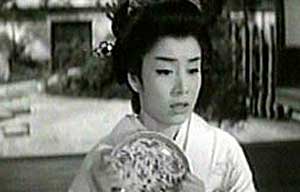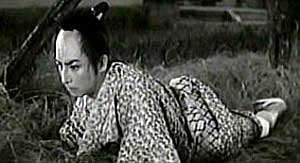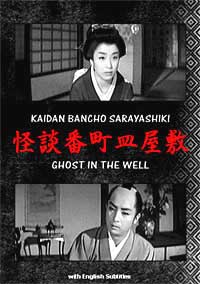 Films about the Ghost of Okiku are based on the kabuki play Bancho Sarayashiki written by Okamoto Kido (1872-1939) & earlier versions from the Tokugawa Era.
Films about the Ghost of Okiku are based on the kabuki play Bancho Sarayashiki written by Okamoto Kido (1872-1939) & earlier versions from the Tokugawa Era.
It was a famous subject for ukiyo-e block prints. The example here at the right is by Yoshitoshi who loved macabre or bloody themes. Her feet are obscured in the portrait because ghosts have no feet & do not touch the ground as they float along.
It was first adapted to silent cinema as early as 1914 by pioneer chambara director Shozo Makino, with remakes by Jiro Yoshino in 1922, Matsunosuke Onoei in 1923, by Zanmu Kaku in 1924, by Rokuro Kashi in 1926, & by Tsukasa Koduki in 1928.
Probably the first significant version was directed Koji Oka as Isetsu Bancho sara-yashiki (Another Version of Broken Dish Mansion, 1929) starring Japan's first horror film diva, Sumiko Suzuki. This "Another" version regards Okiku the ghost of the wronged woman as protector of a later maid also named Okiku; Suzuki played both roles.
It's first sound version was Taizo Fuyushima's Bancho Sarayashiki (Plate-counting Ghost of Bancho, 1937) starring Kazuo Hasegawa as the samurai Harima & Kinuyo Tanaka as the maid Okiku.
The most gruesome version was written & directed by Daisuke Ito, Bancho sara-yashiki: Okiku to Harima (A Samurai's Love, 1954), in which Kazuo Hasegawa reprised his 1937 performance as Harima, & Keiko Tsushima played Okiku.
The story has also been produced for television in 1970 & 1981, & as one episode of an eleven-episode ghost story series for television in 2002. It has also been an influence on modern J-horror, lending its primary imagery to the influential Ringu (The Ring, 1998).
Toshikazu Kono refilmed it as Kaidan bancho sarayashiki (Ghost in the Well, 1957) in scope & black & white. As the story opens we're immediately shown streets of the Yoshiwara pleasure district of old Edo.
 Its look gives the impression that we're in for a serious, gloomy film, but as soon as the first bloodless fight scene occurs between a peasant town knight & the "good" if overly proud samurai, it's clear we're in "family film" territory, which tends to be the case with films starring Hibari Misora. Its look gives the impression that we're in for a serious, gloomy film, but as soon as the first bloodless fight scene occurs between a peasant town knight & the "good" if overly proud samurai, it's clear we're in "family film" territory, which tends to be the case with films starring Hibari Misora.
Harima Aoyama (Chiyonosuke Azume) was a young hatamoto (samurai bannerman) to the Shogun. He seduced his commoner house maid Okiku (Hibari). He promised that his love was no passing infatuation & she would never suffer for it. She resisted his charms for some while knowing full well that they are of classes that do not intermarry, but in time he broke down her resistance, for how could she help but love him.
Political expedience puts the young hatamoto in the way of a marriage with a woman of his own station. This will cement family connections & see his family safely through a crisis, at a time when many clans were finding themselves abolished on any pretext.
Senior overseer Inaba Tateaki's daughter Chizuru (Michiko Hoshi) is pretty, but haughty & unpleasant. Harima cannot bring himself to abandon Kiku, the nicer girl, & love of his heart.
Kiku was distressed by the expectation that she should be willing to be a mere mistress. When she accidentally broke a family treasure, an heirloom plate in the family for generations & the work of a famous potter, it inevitably looked as though she did it on purpose because her lover was to marry another woman.
 The priceless heirloom was to be a gift to the family Harima intended to marry into, but now the set is damaged, & his clan has nothing else as valuable to offer. So Kiku's actions may well have cost Harima his family treasure, his personal rise in status, & puts at risk his very clan's future. The priceless heirloom was to be a gift to the family Harima intended to marry into, but now the set is damaged, & his clan has nothing else as valuable to offer. So Kiku's actions may well have cost Harima his family treasure, his personal rise in status, & puts at risk his very clan's future.
He had protected her for some while due to his affection, but when his wrath finally shows itself, he draws his sword while they are in the garden. She fell injured into the garden well.
At the Hour of the Ox (the Japanese witching hour), Kiku's ghost appears to Harima, who from terror tries to kill her again, though a ghost cannot be cut down with a sword. In every other version of this story that I'm aware of the ghost is vengeful & horrific, for Kiku was legitimately betrayed. But in this version she is loving & forgiving & not motivated by revenge.
No longer valuing his own life, Harima accepts a challenge to duel a great many ruffians & is soon severely injured. During the action sequence, Hibari sings a haunting song on the soundtrack. Most of Hibari's films are at least partially if not wholeheartedly structured as musicals. This one is not. But her fans would've been distressed if she didn't at least sing a themesong.
Harima staggered home knowing he was dying of his wounds & wanting to see the ghost of Kiku ascend from the well one more time before he fades from life. And because his love was true, his own soul rose up to join with hers.
At a scant forty-five minutes this romantic rather than scary version of the traditional summer ghost story is very slight. But Hibari never fails to provide more than ample entertainment, & it's really a very pleasant small film.
A shrine to Okiku stands near Himeji Castle, claiming to mark the very well into which the heroine of this story fell, & the swallowtail butterflies of the shrine are believed to be incarnations of Okiku. Legend insists that Okiku's voice was heard nightly weeping in the well's depths until the shrine was built around it. On the shrine grounds she prayed to as a Goddess, a cthonic divinity with power of beetles, caterpillars, & butterflies.
copyright © by Paghat the Ratgirl
|

